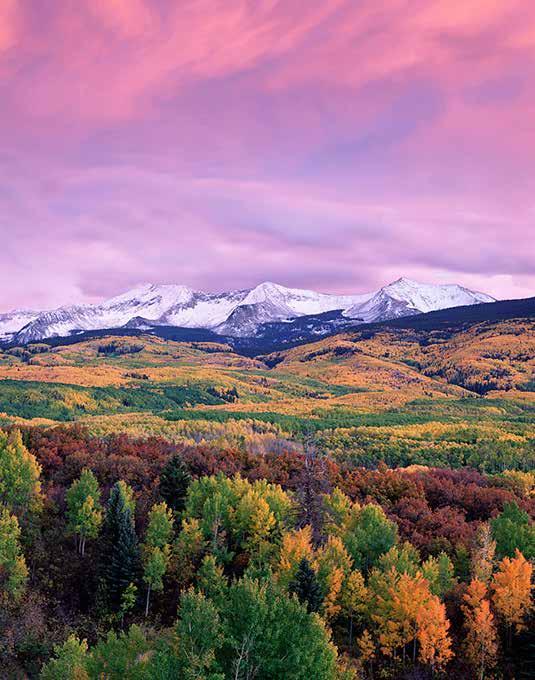
Crested Butte’s fall color byway and Cedaredge’s Applefest
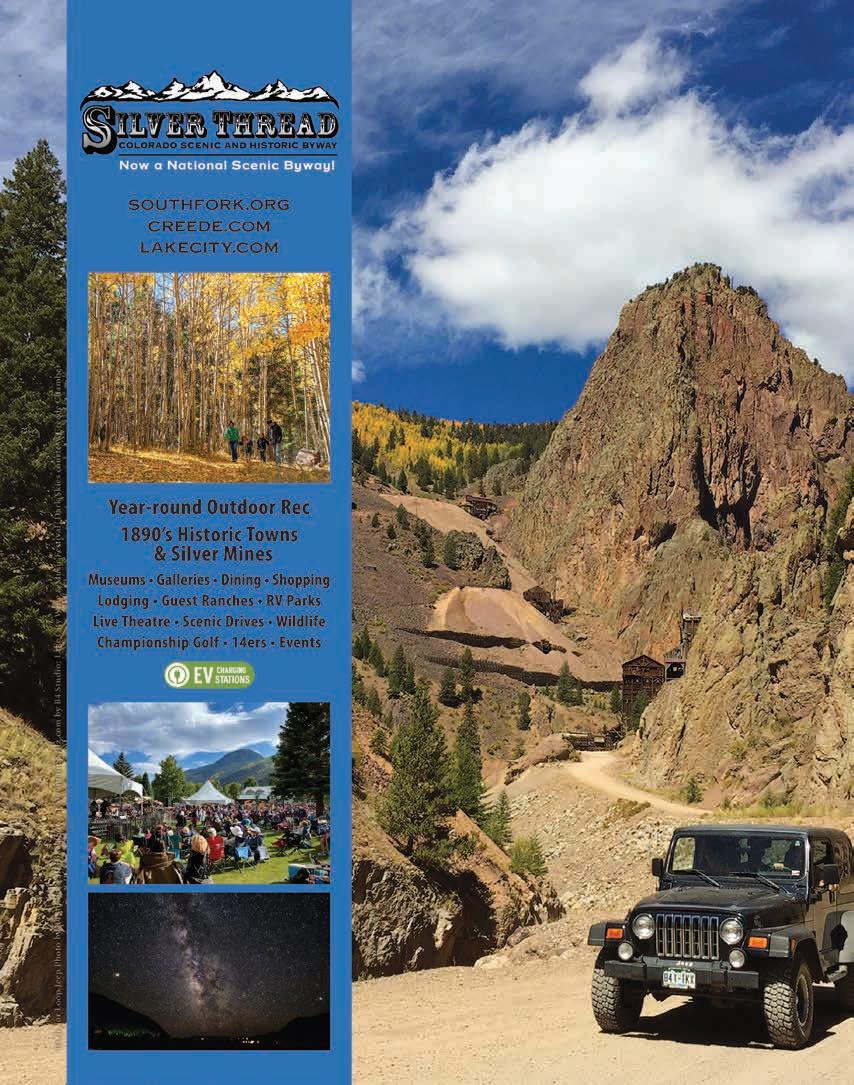
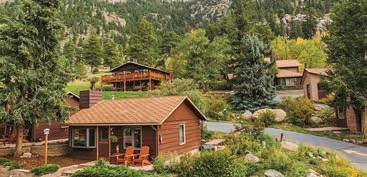


“The
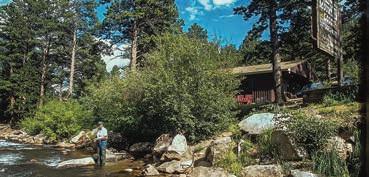
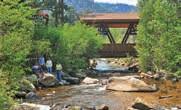













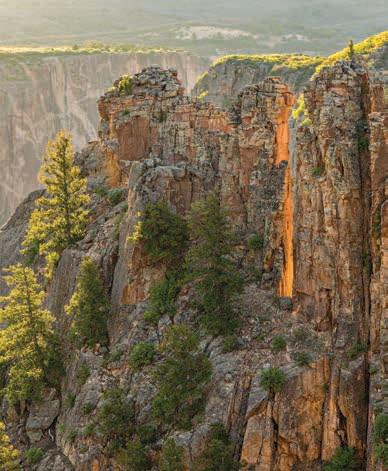


Crested Butte’s fall color byway and Cedaredge’s Applefest




“The
















In this photo essay, we explore the Devil’s Punchbowl, the Devil’s Backbone and other locales blessed with heavenly beauty yet saddled with downright diabolical names.
Story and Photographs by Dawn Y. Wilson
Visitors walk a mile-long pedestrian bridge rising 30 feet above lions, tigers, bears and other carnivores that have found a home near Keenesburg on the Eastern Plains, all thanks to one man’s vision and the help of volunteers.
Story by Tom Hess
People ride the cog railway to the brand-new Pikes Peak Summit Visitor Center to eat donuts at the 14,115foot pinnacle of one of America’s best-loved mountains.
Story by Tom Hess
Photographs by Joshua Hardin
Beneath Grand Mesa, multigenerational family farmers in the Western Slope apple capital of Cedaredge celebrate the fall harvest with apples by the bushelful and plenty of locally made cider at the townwide celebration known as Applefest. Story by Leah M. Charney
Photographs by Joshua Hardin













In this photo essay, we explore the Devil’s Punchbowl, the Devil’s Backbone and other locales blessed with heavenly beauty yet saddled with downright diabolical names.
Story and Photographs by Dawn Y. Wilson
Visitors walk a mile-long pedestrian bridge rising 30 feet above lions, tigers, bears and other carnivores that have found a home near Keenesburg on the Eastern Plains, all thanks to one man’s vision and the help of volunteers.
Story by Tom Hess
People ride the cog railway to the brand-new Pikes Peak Summit Visitor Center to eat donuts at the 14,115foot pinnacle of one of America’s best-loved mountains.
Story by Tom Hess
Photographs by Joshua Hardin
Beneath Grand Mesa, multigenerational family farmers in the Western Slope apple capital of Cedaredge celebrate the fall harvest with apples by the bushelful and plenty of locally made cider at the townwide celebration known as Applefest. Story by Leah M. Charney
Photographs by Joshua Hardin




Snow adorns the Beckwith Mountains with golden aspens below, as seen from Kebler Pass Road. Story begins on page 67.
PHOTOGRAPH BY
TONY LITSCHEWSKI
9 Editor’s Letter

Estes Park, p 00
Buena Vista, p 00
Mount Evans, p 00
Aspen, p 00
Crested Butte, p 00
Cedaredge, p 00
Fort Collins, p 00
Loveland, p 00
Keenesburg, p 00
Golden, p 00
Sedalia, p 00
Divide, p 00
Buena Vista, p 00
Durango, p 00
Manitou Springs, p 00
Colorado Springs, p 00
Observations on life in Colorado by Editor Matt Masich.
Letters, emails and posts from our subscribers.
12 Sluice Box
Wild West gunslingers haunt Durango, Coloradans battle Texans in the Tomato War, Golden shop gets scientifically macabre, and Estes Park honors an elk named Kahuna.
18 Colorado Trivia
Test your knowledge of Colorado’s agricultural bounty. 36 Kitchens
These potato recipes give spuds their turn in the spotlight.

41 Poetry
Our Colorado poets reflect on the beautiful palette of colors that adorns our state as summer turns to fall.
60 Go. See. Do.
A statewide roundup of the best local festivals, events and daytrip ideas gives a plethora of opportunities for fun autumn adventures in all parts of the state.
67 Colorado Camping
A trio of campgrounds near Crested Butte offers campsites amid the stunning fall foliage of Kebler Pass.
70 Top Take
In our editors’ choice photo, a creek ripples through a golden aspen forest at Dunckley Pass near Yampa.

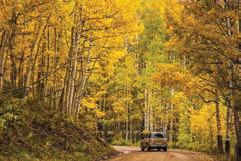
“TIME


Once bustling with gold-seekers, Cripple Creek CO is still a place to visit for those looking to strike it rich in its many casinos – discover historical buildings and gold mines, enjoy unique attractions, the beautiful mountain setting and stunning views of the Rocky Mountains, or simply book a room to get away and delight in all that Cripple Creek has to offer.
Plan your visit at VisitCrippleCreek.com




There aren’t a lot of chain western stores out there. But there are a lot of western stores that don’t live or die providing wranglers, chaps, boots, and gloves to actual cowboys. Not that Grand Mountain Trading Company has anything against tourists.

Every year they outfit people who stay at the ranches in Grand County. What makes them different is that they also outfit the people who work at those ranches, and the family ranches, and the folks who live here who just need quality clothing at an affordable price.
That’s the sort of thing you won’t find in a big box store or a tourist trap. But that’s what you’ll find in Granby. Granby.
Just a little more independent.


SEPTEMBER/OCTOBER 2022
Volume 11, Number 5
Publisher & Executive Editor
Chris Amundson
Associate Publisher
Angela Amundson
Editor
Matt Masich
Photo Editor Joshua Hardin
Design
Jocas A. See, Valerie Mosley
Advertising Sales
Marilyn Koponen, Lauren Warring
Subscriptions
Lindsey Schaecher, Janice Sudbeck, Azelan Amundson, Thaddeus Holdsworth
Colorado Life Magazine PO Box 270130
Fort Collins, CO 80527
1-800-777-6159 ColoradoLifeMag.com
SUBSCRIBE
Subscriptions are 1-yr (6 issues) for $25 or 2-yrs (12 issues) for $44. Please call, visit ColoradoLifeMag.com or return a subscription card from this issue. For fundraising and corporate rates, call or email subscriptions@coloradolifemag.com.
ADVERTISE
Advertising deadlines are three months prior to publication dates. For rates and position availability, please call or email advertising@coloradolifemag.com.
CONTRIBUTE
Send us your letters, stories, photos and story tips by writing to us, visiting ColoradoLifeMag.com or emailing editor@coloradolifemag.com.
COPYRIGHT
All text, photography and artwork are copyright 2022 by Flagship Publishing Inc. For reprint permission, please call or email publisher@coloradolifemag.com.
THE GUY PIKES Peak is named after never reached its summit. Explorer Zebulon Pike and comrades tried climbing to the top on his 1806 expedition but never came close to getting there – though, to be fair, he was attempting to trudge through snow in single-digit weather.
By the time Massachusetts English professor Katharine Lee Bates visited Colorado in 1893, going to the top of Pikes Peak was a routine daytrip for tourists. She took a carriage ride halfway up the mountain, then hopped on the back of a burro for the rest of the uphill trek.
She only stayed at the summit a half hour or so, but that was more than enough time to leave her profoundly moved by the experience of gazing from the mountaintop. The grandeur of the view filled her with inspiration, and poetic words flooded her mind. When she returned to the Antlers Hotel in Colorado Springs that evening, she jotted down these immortal lines:
O beautiful for halcyon skies, For amber waves of grain, For purple mountain majesties
Above the enameled plain!
OK, so maybe the lines weren’t immortal just yet. However, with a little tweaking, Bates’ poem became the lyrics for “America the Beautiful,” which might just be the purest distillation of all that is great and good about our fair land.
I mention all this because I, too, have journeyed to the summit of Pikes Peak – on several occasions. And I’m a little bit ashamed to admit that what struck me most about my time at the top was neither the purple mountain majesties nor the amber waves of grain; what I remember most are the donuts at the Pikes Peak Summit Visitor Center.

I say I’m only a little bit ashamed because I’m hardly the only Pikes Peak visitor to fixate on the donuts. Ask anyone who has been to the summit what they remember most about the experience, and I’d wager four times out of five the answer will be “the donuts.”
As goofy as it might seem, making donuts at the 14,115-foot summit of Pikes Peak is actually a long and storied tradition, stretching back into the late 1800s. You can find out more about it in Tom Hess’ page 44 story on the Pikes Peak Summit Visitor Center, which was rebuilt from scratch – complete with brand-new donut machine –and opened last year. Tom even got to talk with Maria Paniagua, the sole keeper of the top-secret Pikes Peak donut recipe.
Of course, not all high-altitude Colorado culinary traditions are guilty pleasures. On page 52, you can read Leah M. Charney’s story on the healthful and delicious apples grown in Cedaredge. Situated at the edge of Grand Mesa, the world’s largest flat-topped mountain, this Western Slope town is Colorado’s apple capital. This time of year is the best time to get the apples while they’re ripe and juicy at Cedaredge Applefest.
Whether you favor snacking on Pikes Peak donuts or Cedaredge apples, I think you’re in for a treat with this issue.
Matt Masich Editor editor@coloradolifemag.com
Thank you so much for 10 years of this wonderful magazine. It is one of my favorite Christmas gifts for friends and family, and they all just love it so much. It’s the gift that keeps on giving. The content and quality of the articles are beyond wonderful, especially in an age where most everything is online. It’s a joy to hold this beautiful publication and enjoy it several times. Also, I appreciate that you mail me the gift subscription list – it makes my job so much easier.
Margaret Steffens Colorado Springs
Editor’s reply – Thank you, Margaret, for giving Colorado Life. The magazine is growing because of your thoughtfulness. We invite everyone to give gift subscriptions to family and friends this year. Simply call us at (970) 480-0148 or go online to coloradolifemag.com.
My husband and I have lived in Colorado since 1984, except for three years in the ’90s due to job relocations. It took a new neighbor who has lived in Colorado less than 10 years to reintroduce me to this amazing state. She started lending me her Colorado Life magazines. I loved reading them so much, I became a subscriber.
I enjoy reading about places we’ve been and places we have yet to visit. The articles are professionally written, and the photographs are spectacular. Colorado Life publishes real slice-of-life photography and stories about people, places and nature. I read it cover to cover as soon as I receive it in the mail. Thanks for doing such a magnificent presentation of our beautiful state.
Kathleen Satchell Conifer
When I picked up our Colorado Life magazine out of the mailbox I squealed to my husband, “Oh my gosh, look who is on the cover.” One day, a few years back, I was loading some rocks in the trunk of my car in Salida that I had picked up, and Brian Busse walked by and saw me (“Gem Tracker,” July/August 2022).
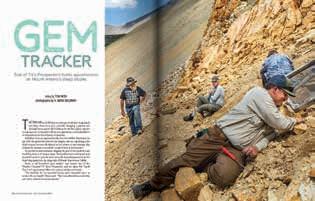
“A woman after my own heart,” he said. “I just love rocks,” I told him. We talked a long time, and I ended up taking pictures of his wife in full Native American apparel. One was his favorite photo of her ever taken. We ran into them on occasion after that and became friends. He invited us up to Mount Antero during filming of the Prospectors TV show. Of course, we went. He also let us prospect. Just as we were getting ready to leave, after not finding anything worthwhile, I moved my hand and a nice aquamarine gem fell out on the ground which is now in a ring on my finger. A ring that carries a story behind it. The entire Busse family are unique and down-to-earth kind of people. You can’t help but admire and appreciate them.
The July/August 2022 issue will be on our coffee table always to add to our already exciting story of the Prospectors, Busses, Mount Antero and my ring.
Betty Crosley Cotopaxi
I would like to praise Colorado Life for providing the rewarding experience I had by reading the May/June 2022 issue, cover to cover, and gaining so many nuggets about your wonderful state.
I live in northwest New Jersey, which has rolling green hills and many opportunities to get outside and play, and received a copy of your magazine from my sister when she spent a weekend with me. She is fortunate to reside in Steamboat Springs, and after reading about the Silver Thread Byway in this issue, we are

making plans to travel it together in the Summer of 2023.
The photography and writing in your magazine are first rate, and when I finished reading the issue, I wanted to move to Colorado myself, and share all the wild beauty and enchanting small-town life. Your magazine provides an appreciation of all the natural wonders that deserve our attention and our respect. I admit to a little fear about reading the copy of Utah Life that my sister also left behind, because I might be tempted to move there instead!
Donna Taylor Sparta, New Jersey
After years of spending summer hiking vacations in Colorado, my wife and I moved here in April 2021. We feel truly blessed to be able to call this wonderful state home. We have subscribed to Colorado Life since the beginning of 2022 and have thoroughly enjoyed the variety of articles, recipes and photographs.
Two articles have really left a lasting impression on me. The first was about 1970s Breckenridge by Jeffrey Bergeron in the March/April 2022 issue (“Boston to Breckenridge”). I am around Jeff’s age and can only imagine what it was like to be young and living/working in an almost frontier-like Breckenridge during the early ’70s. His description of the duel outside the tavern over a woman really had me laughing. Whereas Jeffrey and his friend were expecting a duel featuring possibly guns or knives, they were instead treat-
ed to a non-violent showdown over who could drop their drawers first.
The second article was “Going Diagonal” by India H. Wood in the May/June 2022 issue. As an avid hiker, I was fascinated by India’s hiking adventure from the southeast corner to the northwest corner of Colorado. Moreover, the people she met and the places she got to experience were very memorable. India did a great job in making the point that despite all the political and cultural differences that are at times so divisive in our country right now, the kindness of strangers still prevails. Colorado is a magical place and reading Colorado Life enables us to learn so much more about our state.
Stephen Hatcher Loveland
My husband and I thoroughly enjoyed the “Colorado Musicians” trivia questions in the March/April 2022 issue. We knew some and learned some. Fun addition to the magazine. I also commend the duck photography in this issue – incredible! Moreover, the talented photography in every issue deserves recognition. Thank you for sharing more reasons to love our beautiful state.
Emily Wingert Superior
I really enjoy the magazine – the articles, photos and recipes. Since I am a Colorado native, I always try the quiz. One musician that I did not see in the March/April 2022 quiz is Dave Grusin from Littleton. He won an Oscar for the score for The Milagro Beanfield War. Since I grew up in
Littleton, I am familiar with this musician. His father owned a jewelry store in the shopping center near our house.
Diane Skinner Durango
I’m a native Coloradan, born and raised on a farm in Fort Morgan. We never got the opportunity to leave the farm growing up – our parents never traveled or even left the farm. I started receiving Colorado Life, and from the opening the first page, first issue, it has taught me a lot about this state that we seem to miss out on throughout our lives.
Each issue is a pleasure to read, along with the photos of the colorful places, animals, people and businesses that Colorado has to offer for visitors and even the locals. I look forward to learning about Colorado through the stories and knowledge your staff puts in each issue.
David Lebsock Frederick
In our July/August 2022 story “A Night on Thunder Mountain” and in that issue’s “Letter to the Editor,” we mentioned the record time of 3.717 seconds set by Brittany Force in 2021. The distance traveled in that time was 1,000 feet, not the full quarter mile of 1,320 feet. Either way, it’s still pretty fast.
In the same issue’s story “Canyons on the Plains,” the photo we said showed juvenile turkey vultures actually depicted mature golden eagles. We’ll consult our Audubon field guide more closely next time.
SEND US YOUR LETTERS
We can’t wait to receive more correspondence from our readers! Send us your letters and emails by Oct. 1, 2022, to be published in the November/ December 2022 issue. One lucky reader selected at random will receive a free 1-year subscription renewal. This issue’s winner is Betty Crosley of Cotopaxi. Email editor@coloradolifemag.com or write by mail to PO Box 270130, Fort Collins, CO 80527. Thanks for reading and subscribing!






as
by MADDIE CÔTÉ
Deputy Marshal Jesse Stansel and Sheriff William Thompson settled their differences in true Western fashion in a famous 1906 shootout in front of El Moro Spirits and Tavern in Durango. After a good deal of drinking, Thompson stumbled out of El Moro and mouthed off at Stansel over his poor enforcement of gambling laws. The exchange escalated into a full-blown gunfight, wounding both men. Thompson died en route to the hospital … but his spirit seems to have hung around the tavern.
To this day, employees of El Moro still leave a shot glass full of whiskey for the ghost of the sheriff. If they don’t, things tend to go haywire, and numer-

ous staff have seen glasses fly off shelves and had other paranormal experiences while at work.
It’s stories like these that give the historic mining boomtown of Durango a reputation for being exceptionally haunted. Most stories are rooted in real history: miners who never returned from the mine, cowboys and criminals having shootouts, prohibition, pandemics and a redlight district. Few know Durango’s dark history better than local Joe Nelson, founder of Ghost Walk Durango.
In the ’90s, when Nelson’s friends were purchasing homes downtown, many voiced a similar complaint upon moving in: eerie sounds and inexplicable happenings. For instance, on Third Avenue, the ghost of a little girl wearing a sailor outfit has been reported searching for her parents, who died of the Spanish Flu in 1918. Or over at Durango’s original courthouse, now a quaint townhome, four phantom prisoners have been spotted – perhaps the spirits of men who died in a basement jail cell in a boiler explosion. Contractors have refused to work on that home after their tools mysteriously went missing or got rearranged. “Ghosts hate when you remodel a house,” Nelson explained.
Prohibition and prostitution fostered great secrecy in town. Now considered haunted pretty much unanimously, a network of underground tunnels run beneath the town that were used in the 1920s to transport alcohol and opium. Nearly all of the 32 saloons downtown had brothels on their top floors. The Rochester Hotel claims to still house the apparition of a Victorian-era prostitute. And over at the well-known Strater Hotel, near the Durango & Silverton Narrow Gauge Railroad station, there’s said to be a phantom railway engineer who traipses the lobby. More than 140 years of colorful history gives the town quite the fodder for ghost stories.

There are many elk in Rocky Mountain National Park, but there was only one Kahuna. A massive bull elk, Kahuna was for years sought out by visitors in the national park’s Moraine Park, where he lived with his harem of 60 or more females. His antlers, with their unusually long third tines, were particularly impressive. Kahuna’s many human followers were heartbroken when he died of natural causes at age 12 earlier this year. Some of his fans banded together to form the Kahuna Memorial Project to raise money for a bronze statue of the elk in Estes Park. The memorial will also promote safe wildlife viewing, reminding people to keep at least 75 feet from animals. In its first few weeks, the project raised $30,000 of its target $150,000. To learn more or to donate, visit kahunamemorial.com.


by SARA BRUSKIN
If you wander into a store and find the walls lined with animal skulls, edible bugs and jars of preserved organs, you might think you’ve stumbled into a witch’s apothecary. Despite mystical appearances, however, the Golden Curiosity Shop is firmly based in science and appreciation for the wonders of our world.
Inside his shop in a Golden strip mall, owner Lucas Maas tells people who come in to think of it as a nature and science museum. “This isn’t a haunted house,” he said. “This is a place to come open-minded – a place for curious individuals to ask questions and get real answers.”
Maas himself is usually behind the counter to dispense fascinating – and occasionally horrifying – information about his treasures. One recent acquisition that he’s particularly proud of is a piece of linen from a 3,000-year-old Egyptian mummy wrap. He explains that






mummies are extremely rare and difficult to obtain legally, even though they were once available in abundance.
“People made mummies for thousands of years, and not just in Egypt,” Maas said. “The thing is, Europeans ate most of the mummies from the 12th century right up to the 1800s. They would grind them up into a powder and consume them medicinally in tinctures and teas.”
Other relics of human history in Maas’ shop include Kapton foil from the Apollo 11 moon-landing mission, fragments of the Titanic and the Hindenburg, and a piece of trinitite – a glassy substance that formed when desert sand melted in the world’s first nuclear weapon blast at New Mexico’s Trinity test site in 1945.
Natural sciences are represented with inventory including animal bones, preserved butterflies and other insects, crystals, fossils, organs and more. Maas does his best to ensure everything is ethical-
ly sourced. Every species he deals with comes from a sustainable population, and most of the animals die from natural causes.
One might assume that the average customer would still be uncomfortable being surrounded by body parts in the Golden Curiosity Shop. “What I’m finding is that most people feel that other people will think it’s creepy, but they don’t,” Maas said. “One comment that I get a lot is, ‘I think this is really cool, but I feel like a lot of other people would think it’s kind of macabre and disturbing.’ But it turns out, everybody feels that way.”
Then again, many of the people he chats with have intentionally walked into a shop full of skeletons, spiders and disembodied brains, so there may be some selection bias going on there.
If that sounds like your scene, the shop is located in Golden at The Village shopping center, 17742 S. Golden Road.






by LISA TRUESDALE
Crouched behind a haystack, Rocky Germano heard the crunch-crunch of footsteps as his opponent approached. Just as Germano rose up for the attack, the other guy stumbled, landing in a sprawl atop the low barrier.
“So I just reached down and plonked him right on top of his head,” Germano said, proudly adding that he had bested someone decades younger. “I wonder how long it took him to get the seeds out of his hair.”
It was a small victory for Germano, a transplanted Texan, seeing how his side was vastly outnumbered during the annual Great Colorado vs. Texas Tomato War.
It isn’t really a war, of course, and the only “ammo” allowed is super-soft, extra-juicy, overripe tomatoes, trucked in by the ton. “It’s more of a good-natured rivalry, a big old food fight,” said J. David Holt, the Rotary Club of Buena





Vista member who revived the event last year as a fundraiser for the club’s charitable projects, including the Dolly Parton Imagination Library.
Once held in scenic Twin Lakes, the tomato-throwing extravaganza began in 1982, after an inn owner overheard a tourist from Texas making a ridiculous comment. “The tourist said something like, ‘It sure is pretty here. It’s a shame no one has done anything with it,’ meaning she thought it should be developed,” explained Holt. “So the inn owner decided to do something – about Texans.”
The event was held annually for 12 years. After the inn was sold, an original Tomato War veteran named Larry Bunte organized a smaller event in the tiny town of Guffey. Holt and Bunte met, talked it over, and decided that moving the whole thing to Buena Vista would attract more people.
The 2022 event on Sept. 17 will be held in a sprawling pasture between Bue-

na Vista and Salida. Tomatoes must be thrown – no launching devices allowed – and all throwers must wear protective goggles.
People are allowed to attend without actually throwing tomatoes, though. Last year, there were 80 participants but around 200 spectators, said Holt, who’s now known as “the tomato guy.” He expects to at least double those numbers this year, since they’re also adding a separate event for kids, a band, food trucks and a fire department pumper truck to help hose everyone off afterwards. “Also, a Bloody Mary station, to make good use of some of those tomatoes,” he said. To

signal the start of the main event, two parachutists representing each state will skydive into the makeshift arena, bearing their state’s flag.
Robert Barger plans on his arms being in prime throwing condition. He’s part of a group of Texas Tech alums from the Denver area forming a team to take on their rival Coloradans.
“Outnumbered? Sure, last year the Texans were outnumbered four to one, and that’s what made it a fair fight,” he laughed, in full-on trash-talking mode.
“Although I’m trying to import some more-accurate Texas arms this year, too.” To learn more, visit tomatowar.org.

Soar high above the clouds and gaze down on breathtaking views. Gateway Canyons Air Tours specializes in providing lasting memories that will delight, dazzle and inspire your imagination. Taking you beyond the expected and up to a higher place. Come see for yourself.



EXPERIENCE the splendor of the Rockies at Aspen Winds. The secluded setting along Fall River, among the aspen and pines, offers a relaxing atmosphere. Aspen Winds is located minutes from Estes Park and Rocky Mountain National Park. We offer one and two bedroom suites and in-room spa suites.
Kitchen/Kitchenettes • Gas Fireplaces Fire Pit • Free WiFi • Free Netflix
Cable/Blue-ray DVD • No Pets • Non-smoking
970-586-6010 • 1-800-399-6010
1051 Fall River Court • Estes Park, CO ASPENWINDS.COM

Visit Summit County’s Enchanting

Experience historic charm at Frisco Lodge Our exceptiona l hospita lit y, ernoon w ine and cheese, awardw inning cour t yard and romantic outdoor replace are just a few reasons our g uests rated us t he #1 bed & brea k fast in Frisco and a ll of Summit Count y!
See why our guests think we are the best: http://bit.ly/FriscoLodgeReviews
www friscolodge.com 1-970-668-0195 321 Main St | Frisco, CO fri l d
Test your knowledge of Colorado’s agricultural bounty. by BEN KITCHEN

1 In the early 2010s, the introduction of A.C. Golden Brewing Co.’s Colorado Native beer led to a major jump in Colorado’s production of what crop – most widely produced in the Pacific Northwest – that is critical in the beermaking process?
2 Perhaps better known for its sand dunes, what Colorado valley produces more fresh-market potatoes than any other region in the United States outside of Idaho?
3 The vivid green insect with the scientific name Agrilus planipennis is an invasive species that targets and kills what genus of tree? A program from the University of Colorado Boulder humorously advises people they should “watch your” this type of tree.
4 A whopping 75 percent of all fruit production in Colorado is what fruit, which is particularly prominent in Mesa County, especially in the town of Palisade?
5 The state agritourism board says Anderson Farms in Erie is home to the longest-running example of two forms of autumn entertainment: one where people navigate through a crop, and one where people pick a different crop. Name either.


6
The only U.S. Secretary of Agriculture from Colorado, Charles Brannan, came up with a plan to provide guaranteed income to farmers as a failed portion of what Truman administration program?
a. Square Deal
b. New Deal
c. Fair Deal
7 While Colorado is in the top 10 of all U.S. states when it comes to production of barley, millet and sorghum, it is the nation’s No. 1 producer of which of these grains?
a. Barley
b. Millet
c. Sorghum
8 Which county in northeastern Colorado has the largest agriculture industry? Worth $2 billion, it is more valuable than the agriculture industries of the other two options combined.
a. Logan
b. Weld
c. Yuma
9 Due to a 2020 law designed to make chickens feel less cooped up, by 2025, all eggs produced in the state of Colorado must have what designation?
a. Cage-free
b. Free range
c. Organic
10 Colorado is home to roughly 7 percent of the United States’ sheep, but that only ranks it third for sheep population. Which of the following states has more sheep than Colorado?
a. California
b. South Dakota
c. Wyoming

11 Rocky Ford High School’s mascot is the Meloneers, a reference to the celebrated cantaloupe and watermelon production in and around the city.
12
Colorado is home to 6.6 million cattle, meaning there are roughly a million more cows than people in the state.
13 At 10,361 feet above sea level, Breckenridge’s Continental Divide Winery is the highest altitude winery in the United States.
14 Per state regulations, all livestock in the state must be branded, and a brand must take the form of a tattoo on one of the animal’s hind legs.
15 As long as it is grown in state, dispensaries may market marijuana products with the Colorado Proud logo to assure customers that they’re buying a Colorado product.
Show it in 2023 with our NEW wall calendar

Filled with the gorgeous photography you love about the magazine— ready to hang in your home or office. Order now for yourself and your family!
+ $295 shipping per address
your order, call
No peeking, answers on page 68.


Statewide tour of diabolically named landmarks
THE SETTLERS WHO named many of the places in Colorado were drawn here by the heavenly beauty of the Rocky Mountains, along with the promise of wealth and fortune from the gold and other precious metals hidden within the towering peaks. One might think the state’s divine-looking landmarks would have inspired names involving God or heaven.
However, there was a reason why many westward migrants ended their journey at the base of the Front Range: Those were difficult mountains to cross. And as many miners, trappers and explorers discovered, the mountains were harsh, jagged and unforgiving. The windswept Eastern Plains and unearthly

canyons of western Colorado were dry, dusty and rugged, making them just as merciless. These natural formations could only have been the creation of the devil himself.
Colorado is peppered with destinations – mountains, rivers, trails, swimming holes, natural landmarks – with diabolical names. Although the precise origins of the names have been lost to time, one can only imagine the struggles the early Anglo settlers who named these locations must have experienced to give them such devilish names.
The names stuck, and modern-day explorers can play their hand with the devil at these adventurous destinations throughout Colorado.
Colorado came in at No. 19 on the list of total lightning strikes per state in 2021, with 3,451,756 cloud-to-ground strikes and cloud pulses. Because of this, hiking above tree line is ill-advised during summer afternoons when storms pass across the high peaks. Before even starting up the trail to Devil’s Playground, which sits above tree line on Pikes Peak at an elevation of 13,000 feet, a sign warns hikers that the trail’s name comes from the way lightning jumps from rock to rock during a thunderstorm.
This trail starts outside of Divide near the Crags Campground in the Pike National Forest on Pikes Peak and climbs a grueling 2,987 feet, but the views are like heaven on earth, no matter what the trail is named.

The last of the four original Front Range fire lookout towers, the Devil’s Head Lookout Tower sits high above the Rampart Range near Sedalia at the summit of the 9,748-foot, ominous-looking granite outcrop from which it takes its name.
The venerable tower is still in use today and recently reopened to visitation

after being closed for three years while undergoing maintenance work. The U.S. Army 973rd Engineer Construction Battalion from Fort Carson built the tower in 1951 after dismantling the 1919 lookout station. A trail leads to the tower, and the area also has ample ATV trails and a nearby campground.



Located in the foothills on the western edge of Loveland, Devil’s Backbone is a 72 million-year-old, 2-mile strip of Dakota sandstone. Though the name comes from the jagged rock formation that resembles the backbone of a slithering, rocky monster, the beauty here presents more like heaven than hell.
Devil’s Backbone Open Space includes more than 17 miles of trail connecting Rimrock Open Space, Coyote Ridge Natural Area and Horsetooth Mountain Open Space, plus a portion of the 15.9-mile Blue Sky Trail.
As you stand on the precipice of the steep rock walls, you can listen to the angel or the devil on your shoulders to determine if you should jump the 25 feet into the Roaring Fork River below.
This popular cliff-jumping spot near mile marker 50 on Colorado Highway 82 between Independence Pass and Aspen entices adventure-hungry souls willing to listen to the devil. The emerald-colored river flows down a waterfall and swirls into a natural rock bowl almost three stories below the cliff edge. Summer is the best time to take the plunge, but even then, the water is extremely cold, the current is always strong, and the river can be unpredictable, so swimmers take the dip at their own risk.
Deep in the Mount Evans Wilderness, hikers will find the Hells Hole Trail, a route with an uninviting name but well worth the effort. This destination should be completed in the fall to enjoy the abundance of autumn shades.
At the end of summer, when the trailhead has fewer cars and the aspens and willows start their annual conversion to various golden tones, you will enjoy more serenity on this trail – possibly with an occasional moose along the hike or bugling elk in the glacial valley at the trail terminus. Stretching about 9 miles roundtrip, this is a long, moderately challenging hike with a gradual elevation climb of 1,912 feet that passes through aspen, ponderosa and bristlecone pine forests before ending in a glacial cirque full of golden willows below 13,602-foot Gray Wolf Mountain.

• Devil’s Lookout Trail and Overlook in Black Canyon of the Gunnison National Park
• Devil’s Canyon off State Highway 103 in Arapaho National Forest
• Devil’s Canyon Trail System in Fruita
• Devil’s Causeway in the Flat Tops Wilderness near Yampa
• Devil’s Thumb tower in Indian Peaks Wilderness
• Devil’s Gate High Bridge along the historic Georgetown Loop Railroad




by TOM HESS
A1 ½-MILE-LONG PEDESTRIAN bridge rises 30 feet above eastern Colorado prairie grass. Below is not your typical rangeland scene: a pride of lions, a streak of tigers, a sleuth of bears and other wild animal societies that reside on the Wild Animal Sanctuary’s 10,000-acre fenced preserve in eastern Weld County, off Interstate 76 near Keenesburg.
The carnivores, most of them rescued from neglectful handlers, take no notice of the visitor in hiking boots trip-trapping, clip-clopping like a troll on the bridge over their heads.
The visitor can’t see the animals that are resting in the shade of the bridge, and he sees neither lion nor tiger nor bear in the near distance. He picks up his pace, hoping an animal will come into view farther down the path. One of the sanctuary’s 160 volunteers invites the visitor to slow his pace and not be in such a hurry.
The visitor stops, lifts his eyes and looks to the horizon, just as the volunteer suggests. Off in the distance, a lion sleeps upside down in broad daylight, its four legs straight up. Bears play in a pond; others wrestle each other. Jaguars stalk one another.
The animals of Wild Animal Sanctuary seem relaxed, unpressured, sociable within their species, acting as they would in the wild, as if they had never been confined or abused. That’s when the visitor, like thousands before him, realizes that Wild Animal Sanctuary isn’t a zoo, organized for his entertainment. Instead, it’s a home for healing, and the animals’ interactions tell him it’s working.

THE WALKWAY ABOVE Wild Animal Sanctuary is just one of the lessons that founder Pat Craig learned decades ago tending rescued wild animals on his family’s Boulder County farm.
The 18-acre farm came with a chicken coop built in 1895 for a commercial egg operation, “with about a million cages,” Craig said. In converting the coop into his first wild animal enclosure, he stood on the roof, installing new plywood on the rafters. Below him were his first rescues.
“I would hit nails, saw a piece of wood, concerned and watching, but none of them gave a hoot,” Craig said. The animals didn’t care what he was doing when he was 30 feet up on the roof. That’s why the Keenesburg sanctuary’s walkway is up to 30 feet high, and why the sound of hiking boots doesn’t draw their interest or concern.
Craig began rescuing abused animals
after witnessing firsthand at age 19 the deplorable conditions in a poorly managed zoo back East. That eye-opening tour launched his lifelong commitment to wildlife preservation. His work began in Boulder, then led him decades later to create the Wild Animal Sanctuary near Keenesburg and another, the Wild Animal Refuge, in Baca and Las Animas counties near La Junta. The Keenesburg site is open to the public. The La Junta site is not.
Among the first animals Craig rescued was a jaguar, which came to him by way of a Texas sheriff, a Colorado furniture salesman and a Hollywood animal trainer.
A disreputable circus traveling through Texas couldn’t pay its bills and fled in the night, leaving behind equipment and animals. The sheriff who took possession of it all reached out to Jake Jabs, the Colorado furniture salesman whose ads appeared on
regional television with exotic animals. Jabs asked Denver-based Hollywood animal trainer Sidney Yost for leads on where the sheriff might safely place the jaguar. Yost told the sheriff of a “kid” in Boulder who was building an enclosure for abused and abandoned animals. The sheriff contacted Craig, who brought the jaguar to Boulder.
Most of animals at the sanctuary arrive from such emergencies. Whether in small zoos or private homes, wild animals’ need for food and care quickly overcome their owners’ resources.
Word first spread of Craig’s work after he received his state and federal licenses that allowed him to care for the wounded wild. Hundreds of letters requesting shelter filled his mailbox. Some of those who heard of the animals he had wanted to see them. But Craig didn’t rescue the animals for exhibition; he wanted them to heal.
FOR THE FIRST five years, Craig kept things quiet. He enclosed his growing collection of animals with eight “hot” wires, barbed wire and plum rose bushes around the farm. No visitors allowed. Craig paid for his wildlife passion through the financial discipline he learned working in his father’s automotive businesses.
Craig’s parents wanted their children to grow up on a farm and learn to work hard. Craig’s father also owned and operated a Boulder tire store and later several local gas stations. Craig worked both. He began prying Michelin radials, Firestones and Dunlops off tire rims at age 9. “By the time I was 11, I was a better tire buster than grown men” at SOS Tire Service.
Craig’s father bought him a ’65 Chevy Impala SS when he turned 16. “I wanted a hot rod. It looked like a giant tuna boat. I was really bummed,” Craig said. The disappointment didn’t last. The roar of wildlife soon crowded out a desire in Craig’s heart for the roar of a Corvette engine.
After returning from the zoo visit that changed his life, he held a number of jobs. Each of them helped pay his animal bills and also gave him key insights. When Craig substitute-taught kindergarteners in Longmont, the children seemed to him just like his wounded animals. Some of the kids came to class fearful, while others had the confidence that brothers and sisters would support them.
“To this day I always think back on that experience,” Craig said. A spirited leopard named Jumanji, rescued years ago from a roadside zoo, outlasted other jaguars who had less will to live. “The animals like Jumanji who have the tenacity to live, they survive the abuse,” he said. “Just like kids.”
Craig’s menagerie outgrew the family farm, so he moved next to a cement factory in Lyons, then to Keenesburg, each time putting himself at financial risk, taking out secured loans. Craig had hoped that his private work would help solve the problem of wild animal abuse. It didn’t.
“I’m getting calls from law enforcement about wild animals in houses, barns, basements. Zoos are dumping them in a lot of places,” Craig said. “I realized, this is getting crazier, not better.”
Craig reluctantly started offering private presentations to educate a public that didn’t


know what he had learned about wild animals. Much of his practices and policies reflects Craig’s hard-won education.
One lesson was especially painful. The Texas jaguar he rescued in the early days nearly tore off Craig’s arm as the two squared off within the farm enclosure. The animal wanted the water container Craig was carrying and attacked, going for his throat. Craig rolled onto his stomach and protected his neck with his arm. The jaguar tried wrenching his arm away, tearing it. The jaguar stopped its attack after Craig’s mother yelled at the cat. Lesson: Even an animal accustomed to human handlers can turn on them, as Mantacore the trained tiger did in Siegfried & Roy’s now-retired Las Vegas show, attacking and nearly killing Roy Horn in 2003.

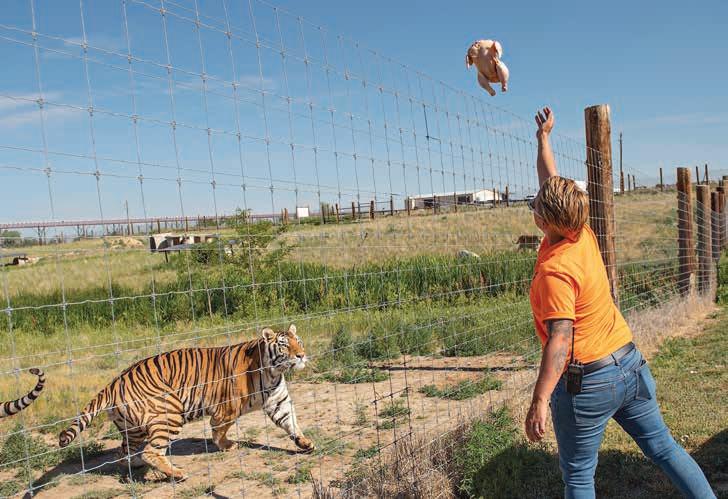
Craig is the Six Million Dollar Man, spreading his fingers to reveal just how thick a file of medical bills he maintains. Injuries occur even when an animal is playful. A tiger once ran by, striking his knee. Such collisions happen often. He’s walking now on new knees. A playful bear tossed him 10 feet, dislocating his shoulder. Now in his 60s, Craig is moving more painfully. Other people install the new wildlife dens and other infrastructure at Keenesburg and La Junta.
Craig seems shy and speaks softly, at least until he knows that his guest loves his animals as much as Craig does. He loves them so much, he presses on decade after decade, through frequent injury and financial shortfalls, when others might simply give up and walk away.
AMONG THE ABUSED animals in Craig’s remote southeastern Colorado refuge are the tigers from the notorious Tiger King TV series.
Joe Exotic of Tiger King caged his tigers in too-small spaces, failed to nourish them, neglected their teeth and shot some in front of the others. “It took months for the tigers to realize that not everybody is going to beat them,” Craig said.
The southern refuge received 150 animals from Joe Exotic and other “nefarious characters,” Craig said. They roam 9,000 acres of forest, nothing like the treeless plains at Keenesburg.
“Down in La Junta, when they hear a noise, they have to walk clear across the habitat to see what it is,” he said. “This will be good for them, giving them more of a sense of needing to be on patrol, like they would do in the wild.”
The Refuge’s $7 million price tag at first seemed out of reach until Craig did the math: a cost of $777 per acre. The number inspired an idea: give donors the chance to buy an acre for the animals. It worked. Craig is within $200,000 of his goal after just three years.
Founder Pat Craig rescued his first wild animal when he was 19. Robert Brazeal gives a lion medication wrapped in raw pork. A memorial honors a jaguar named Freckles, Craig’s first rescue.




The public can see Craig’s animals only in Keenesburg, where the facility is open year-round. The sanctuary employs three veterinarians. A staff of about 80 helps with animal care, such as feeding, or with public-facing jobs like admission and the gift shop. Craig long ago transferred ownership of the sanctuary and its animals to a nonprofit foundation.
Signs at the sanctuary warn against several things that can trigger an adverse reaction for guests and animals alike. One is tobacco, which some abusive former owners had used to trigger their animals. The other is dogs. Dogs are not allowed on the property – not even service dogs, and most definitely
not on the elevated walkway, because instinct drives them to become uncontrollable.
“The big cats pick up on it. They hear the ‘click, click, click, click’ of the dog’s nails,” Craig said. “The animal below moves; the dog looks over the edge; the dog freaks out. It’s an instinct their owners cannot control.”
Visitors who bring dogs despite the warnings online and on site create a staffing challenge at the sanctuary. Because so many visitors ignore the warnings, leaving their dogs in their vehicles, staff must monitor the parking lot. If a left-behind dog appears to a staff member to be distressed by summer heat, “we’re going to
break your car window and call the Humane Society,” Craig said.
In Craig’s view, animals should not suffer because of human choices – not a visitor’s dog, and not animals bred without thought of their long-term care.
Among those animals who have received Craig’s attention for years is Dillan, a black bear rescued from a shooting range where he rocked against a concrete wall for years and ate to excess. Dillan thrives at Keenesburg, but Craig is still working on shedding the bear’s weight. Craig’s team built a pool in which Dillan can splash around and burn calories. And he’s no longer alone. Dillan’s got a girlfriend. Life is good now.





896 Cap Rock Drive • Cañon City
Virtual address: https://www.aryeo.com/v2/896-cap-rock-dr-canon-city-co-81212-1928493/branded
Imagine waking up to the stunning panorama of Pike’s Peak in the large picture window at the foot of your comfy bed. This uniquely private mountain property is a world away from the hustle and bustle of big city life. Ideal for weekend retreats or a peaceful and serene private hideaway. Also, there is a cute and cozy 2-bedroom separate guest house with a one car garage — very private accommodations for your special guests.
731 Macon Ave. • Cañon City, CO 81212
719-275-7404 frontierwestrealty.net




recipes and photographs by DANELLE McCOLLUM
WHILE THE HUMBLE potato seldom gets top billing in a meal, potato dishes often end up stealing the show. These sides each have that star quality, from incredibly rich mashed potatoes with cream cheese and garlic, to cheesy lemon parsley potatoes that use two different colors of spuds, to outside-the-box sweet potato wedges with a tangy bacon vinaigrette.
Crispy roasted sweet potato wedges come alive with a tangy bacon vinaigrette. The savory elements offer a nice contrast to the sweetness of the potatoes, making this dish popular even with folks who don’t always love sweet potatoes.
Brush large baking sheet with about half of oil. Place pan in oven until hot, about 5 minutes. Meanwhile, in large bowl, toss together sweet potatoes, paprika, salt, pepper and remaining oil. Remove pan from oven and carefully place potatoes in single layer on hot pan. Bake at 425° until tender, 18-20 minutes, turning once halfway through cooking.
While potatoes are roasting, cook bacon in large skillet over medium heat until crispy. Remove to paper towel-lined plate to drain. Add garlic to pan and cook until fragrant, 1-2 minutes. Stir in vinegar. Place cooked sweet potatoes on large plate or platter and drizzle with vinegar mixture. Sprinkle with bacon, parsley and chives. Re-season with additional salt and pepper, if needed. Serve immediately.
3-4 Tbsp canola oil, divided
4 sweet potatoes, peeled and cut into wedges
1 ½ tsp paprika
1 tsp salt
1/2 tsp pepper
4 slices bacon, chopped
1 clove garlic, minced
4 Tbsp red wine vinegar
1 Tbsp chopped fresh parsley
1 Tbsp chopped fresh chives
Serves 4

Two kinds of potatoes are baked in a creamy cheese sauce with a hint of lemon. This dish is a bit like a cross between roasted potatoes and au gratin potatoes. The combination of red and yellow potatoes makes for an attractive side dish.
Coat 9x13-inch baking dish with cooking spray. In medium bowl, whisk together cream, butter, garlic, salt and pepper. Arrange potatoes in even layer in prepared dish and pour cream mixture evenly over top. Cover and bake at 375° for 45-50 minutes or until potatoes are tender. Uncover and sprinkle with cheese, lemon zest and parsley. Bake 5-10 minutes longer, or until cheese is melted and golden. Let stand 5 minutes before serving.
1 cup heavy cream
5 Tbsp butter, melted
2 cloves garlic, minced
1 ½ tsp salt
1/4 tsp pepper
1 ½ lbs baby red potatoes, cut into 1-inch chunks
1 ½ lbs baby Yukon gold potatoes, cut into 1-inch chunks
2 cups shredded Swiss cheese
Zest of one large lemon
2 Tbsp chopped fresh parsley
Serves 8
These creamy, fluffy mashed potatoes are loaded with minced garlic, butter, cream cheese and fresh parsley. Leaving a bit of the skins on the potatoes makes a nice presentation while adding a bit of nutrients. Milk or cream can be added to get potatoes to the desired consistency but is often unneeded. If adding extra liquid, start slowly and add gradually.
Bring a large pot of salted water to a boil. Add chopped potatoes and cook until fork tender, about 15 minutes. Drain potatoes and place in large bowl. Add butter, cream cheese and garlic. Mash potatoes with potato masher until they reach desired consistency and texture, adding milk or cream, as needed. Stir in parsley and season with salt and pepper, to taste.

10 medium russet potatoes, peeled and coarsely chopped
1/4 cup unsalted butter, diced
8 oz cream cheese, softened and cubed
3 cloves garlic, minced Milk or cream, as needed
1/4 cup chopped fresh parsley Salt and pepper, to taste
Serves 8
The editors are interested in featuring your favorite family recipes. Send your recipes (and memories inspired by your recipes) to editor@coloradolifemag.com or mail to Colorado Life, PO Box 146, Timnath, CO 80547.



























































As summer green turns to autumn gold, the full spectrum of nature’s rich palette comes alive. Our poets celebrate the vivid hues that earned Colorful Colorado its well-deserved nickname.
Sandy Morgan, Colorado Springs
October snow slips in at night. A wand waved over us while we dream.
Trees – green, gold and scarlet –awake baptismal white, shake themselves free in morning sun. Along with half or all their shocked leaves.
Grass drinks the snow, thirsty for this ice-cold draught. The taste of winter fades before noon.
But has left its mark: squirrels squabble and plump their nests in the eaves over my kitchen.
Robert Charles Howard, Estes Park
Spare no lament for the maple leaves that hail their impending fall with blazing gold and scarlet concerts bright as Christmas brass in marble halls.
How bold their radiant hymns resound –mute to the sweatered ones below whose treble scraping rakes – raise smoldering pyres of the fallen.
Steamy plumes from cocoa mugs blend with burning oak and maple wisps as rakers chant their own sweet airs, “The colors surprised this year, didn’t think we’d had the rain.”
So spare no lament for the maple leaves whose jubilant anthems, raised beneath the harvest moon, herald their fall with rainbow alleluias.
Janice Volz Schefcik, Centennial
A game of hide and seek In flashes of gold, Tease this tired hiker to seek the prize. A canopy of quaking leaves Beckoning me to rest beneath.
Charles Ray, Evergreen
autumn mountain dance colors shimmy in the breeze gold aspen leaves
early snowfall
young deer bending green branches chewing pine needles

Arlene Spevak, Yardley, Pennsylvania
They speak of her mountains Of their purple majesty, proud peaks Remarkable beauty for all Lifelines for some
For one who travels far to find Embraceable meaning for lost souls The red of the rocks lends untarnished hope Thinking on Maroon Bells
Saves life again and again Green fields and yellow sun Always await my return
Purple mountains in the distance Close to my heart, near in my spirit Always giving, always there
Marina Ashworth, Denver
Crayons have colors with catchy huesome names Hmm, you think you have seen them all? Lady Colorado created her own melange that she joyously bestows to enthrall
View pine tree green, a brook’s sweet blue Rocks subtle shades of gray and browns Her dirt has hints of black, red and tans A million tints to boot out your frowns
How many tinges can flowers behold? How many tones can skies display? Waters, plants and critters that move kindle tints that flash her array
To be most fair and true complete There’s more colors beneath daylight When soleil sets and day colors go soft New hues wake in the realm of night
J. Craig Hill, Grand Junction
Red for the male finch in search of a mate Orange for the peach from the Palisade shack Yellow for the rapeseed field east of Limon Green for the aspen bud in the spring Blue for the columbine by the side of Bear Lake Indigo for the evening sky above Fruita Violet for the lavender in the pot on my deck
All seven for the rainbow over Monument Road
DO YOU WRITE poems about Colorado? The next poetry theme is “Colorado Memories” for November/December 2022, deadline Sept. 15; the theme is “Sunrise” for March/April 2023, deadline Jan. 1, 2023. Send your poems, including your mailing address, to poetry@coloradolifemag.com or to Colorado Life, PO Box 270130, Fort Collins, CO 80527.











New Pikes Peak Summit Visitor Center and cog railway serve up sweet, century-old tradition

THE DONUTS TUMBLING by the dozens every hour from a new fryer in the new Pikes Peak Summit Visitor Center make the center’s builder, Rob Clough, happy. Not happy the way donut addict Homer Simpson is happy at the sight of pink frosting and sprinkles. An extreme athlete on bike trails and rock walls, Clough prefers protein over pastries. What summit center construction superintendent Clough values most about donuts is the long line of guests waiting eagerly to buy the time-honored treat.
There is no sign in the visitor center informing guests that the donuts will be edible only at 14,115 feet. Pikes Peak donuts make lousy take-home souvenirs; they collapse at lower altitude, no longer fluffy enough to enjoy. Best to eat them on the spot. The sign may not be necessary because most visitors already head straight from The Broadmoor Manitou and Pikes Peak Cog Railway to the donut line and take a seat to eat their treat.
People have been taking the cog railway to the top of Pikes Peak to eat donuts since the late 1800s. It is an old tradition that was reborn last year when new railway tracks, a new Summit Visitor Center and new donut machine all debuted. As familiar as the updated mountaintop experience is to longtime visitors, there are some key differences.
Level, sure-footed pathways and platforms now extend in every direction, replacing ice-slicked gravel and ankle-twisting boulders. Clough was eager to bring his family up to see what he and his team accomplished, including a concrete foundation that allows the permafrost below to remain frozen and stable and the visitor center space above to be toasty. Permafrost melted by the unguarded heat of past summit houses crippled their foundations. The concrete-polymer-concrete sandwich beneath the feet of today’s visitors will warm the hearts of structural engineers and maybe their families. For nearly everyone else, it’s all about the donuts.
Donuts are a longstanding tradition at the Pikes Peak Summit Visitor Center. Travis Turner and Lisa Messick prepare a batch of donuts to serve to visitors at 14,115 feet.
Clough recalls the moment when he ate from the last batch of donuts produced in the previous 1964-vintage summit house before it closed for demolition in January 2021. He compares that donut to the one he tasted from the first batch baked in the new machine, which started up a few months later. His review: “The new donuts taste better.” Good thing. Thousands count on a tasty experience.
THE TALE OF the Pikes Peak donut begins after the U.S. Army abandoned a weather station at the summit in 1888. The structure reopened as a donut and coffee shop, the brainstorm of a Manitou Springs mayor whose name is lost to history but whose quirky idea endured. One wall of the Army station still stands – a relic Clough’s crew took great care to preserve. The donuts and coffee moved to the first summit house, constructed in 1892, a year after the cog railway reached the summit. Donuts have remained on the menu ever since, in one new summit house after another.
Why donuts at the summit? The stress of thinner air – providing just 60 percent of what the body is accustomed to below 8,000 feet – and dizzying heights trigger the body’s desire for salt, sugar and fat, which will help produce what the brain needs.
Marcia Kinner of Colorado Springs knows something about high-altitude cravings. She and her husband Robert once owned the highly successful Donut Mill in Woodland Park, its altitude above 8,000 feet.
“Customers said our donuts tasted better than what they remember tasting at lower elevation,” Kinner said. That matches her own memories from childhood.
“My Dad drove us up Pikes Peak in his Plymouth sedan when I was 10, and I remember the donuts tasting better.”
The cog railway and Pikes Peak Highway predate the Mount Evans Scenic Byway, the only other mechanical means for reaching the summit of a 14er in Colorado. The founder of the Simmons Bedding Co. hired laborers with pickaxes to build the first cog railway, with construction starting in 1889. Pikes Peak’s proximity to Colorado Springs prompted Broadmoor Hotel builder Spencer Penrose to construct the Pikes Peak Highway to replace


Passengers at Manitou Springs’ cog railway depot prepare to board special Swiss-made railcars for the


an old carriage road – the one “America the Beautiful” writer Kathleen Bates traveled for her brief but inspiring visit to the summit in 1893. Penrose publicized his highway by founding the Pikes Peak Hill Climb auto race in 1916, which is still running a century later.
The Pikes Peak region attracts visitors to the base of the mountain for other reasons as well. The vertical red rocks of Garden of the Gods offer a natural frame for photos of the mountain, and Manitou Springs’ famed artesian wells bubble up with flavorful water for thirsty visitors, just steps from the cog railway station.
A FRESH BATCH of donut consumers arrives each day at the new city of Colorado Springs-owned Summit Visitor Center aboard The Broadmoor Manitou and Pikes Peak Cog Railway. The ride in Swiss-made railcars takes about an hour on new tracks that the railway’s owner, The Broadmoor Hotel, recently spent three years and $100 million installing. More than half a million people visit the summit each year, arriving by cog or car or on foot, making Pikes Peak the most visited mountain summit in North America.
Whatever the means for reaching the summit, the scenery changes on the way up. The foothills zone at the cog station includes ponderosa pine, piñon and juniper woodlands, as well as paintbrush, goldenrod and larkspur wildflowers. As the cog climbs, and cityscapes subside, rising high are lodgepole pines, Engelmann spruce and Douglas firs, with sagebrush huddled below. In the subalpine zone, at mile marker 4, the Engelmann take over, and at the top end, become deformed by harsh conditions. At mile marker 6, all that’s left are tundra grasses, mosses, sedges and lichens on the boulders and short wildflowers between them. The lightning dash of a marmot might catch the eye. On foot, all is quiet, except for the wind.
The new cog track guides passengers along a path through unique Colorado history – history made entertaining by that day’s conductor, Ryan Miller. He’s dressed for the part in a traditional conductor’s uniform, right down to the gold watch chain hanging from his buttoned vest.
The windows in the railcars pull down. Miller advises guests to resist the tempta-
tion to hold their camera phones outside. The train won’t stop if a tree branch or rock face bumps a hand and the phone it’s holding falls trackside. At that point, Miller says, “congratulations, you will have made a donation to the cog railway.”
On the way up, at 9,051 feet, Miller points out the Ruxton Hydroelectric Plant, built in 1925 and operated by Colorado Springs Utilities next to Lake Moraine. The original stone facade remains intact. The plant still powers homes in Colorado Springs.
Not far from the plant is the site of Ruxton Park, a town where the early cog railway stopped, three miles up from the depot. The town featured the Halfway Hotel, a 22-room lodge that served donuts and coffee to cog riders until it burned to the ground. The town is now in ruins.
So that guests won’t be confused by what he means by “left” and “right,” Miller points out that the hydro plant and caretaker home appear on the three-seat side of the railcar.
On the two-seat side, at 12,129 feet, is Windy Point, the name for a rock shelter built alongside a now-demolished water stop for the earliest, coal-fired cog engines. Windy Point is aptly named, because winds here can blow up to 100 mph.
Wind factored into the design of the new Summit Visitor Center. The design team wanted to provide guests a picture-window view of Mount Rosa, the lower mountain to the southeast of Pikes Peak’s summit that historians say explorer Zebulon Pike climbed in 1806; Pike never reached the summit bearing his name.
To ensure that flying objects would not shatter the colossal Mount Rosa window, the summit design team tested glass thicknesses and composition. In a test lab, they repeatedly shot two-by-fours at 200 mph – double the highest wind speeds on the mountain – at a window composed of two panes, with lamination at the center. The glass’s endurance passed the engineers’ test. To make the winning windows visible to birds, the team etched the panes with horizontal lines.


At top, people enter the new visitor center, completed in 2021. At right, a plaque displays lyrics from “America the Beautiful,” which Katharine Lee Bates wrote after visiting the summit. Above, a cog train visits the summit in the early 1900s.
ONCE COG RIDERS REACH the summit, visitors head straight for the donuts. Making donuts at 14,115 feet is a feat that involves daily trial and error.
Maria Paniagua is front-of-the-store manager at the summit’s donut counter, a job she’s held for 13 years. She’s also the sole keeper of the secret donut recipe, written, she says, in faded cursive on a paper preserved in a plastic sleeve, inside a book she safekeeps. That’s about all Paniagua will say, except that a “tweaked” copy with “very minor changes” in black Sharpie is also part of the written record that few will ever see.
Current donut cook Travis Turner said he must adjust the mix of ingredients daily for humidity and temperature. His first batch on a cool, overcast morning came out “too fluffy” and had to be discarded, leaving guests who arrived at 10:30 a.m.

waiting in line until he got it right. Turner knows Paniagua’s secret recipe but has never seen it; it’s all in his head, and he’s not revealing much about it, either.
On snowy days, Paniagua and Turner can’t drive their own vehicles up the mountain to get an early start on donuts. Instead, they must ride the first cog up, departing at 8:40 a.m. The donut machine then takes 20 minutes to heat up, and at least a few more minutes to make edible donuts. The everyday commute to the top of a 14,115-foot mountain is routine to them, whether by private car or cog.
Cog and summit planners give passengers about 40 minutes at the top, expecting from experience that the lungs of most visitors will struggle with the thin air and want to head back down sooner than later. Forty minutes gave guests just enough time to shuffle with the crowd to

the line for donuts and coffee, a restroom visit – there are none on the train, nor food or drink – a quick look at the merchandise at the gift shop, but not a walk to one of the new sure-footed overlooks. That would need to be a priority on the next visit.
Wildlife sightings can be few and far between. There are exceptions, like the day in 2013 when a llama from Cripple Creek meandered toward the cog railway. Llamas are herd animals, so a cog crew released a pair of rescue llamas in hopes they would coax the lost llama off the mountain and out of harm’s way. The plan failed. One rescue llama wandered off, and the other simply lay down by the tracks at timberline. A crew loaded that rescue llama onto a flatcar and carried it down the mountain.
On the more recent ride up, a whistling marmot – also known as a “whistle pig”


– was the only wildlife to make an appearance. No matter. For guests in the railcar, the scenery satisfies.
Back at the summit, the train whistle sounds. Time to depart. Railway conductor Miller had said on the way up that those who miss the signal of imminent departure “will become hikers.” It got a laugh, but the guests knew it was no joke. Everyone is in their assigned seats as the train departs. No one’s hiking back.
Miller reassures everyone that the train’s descent on especially steep passages, such as Son of a Gun Hill’s 25 percent grade, is controlled by “dynamic braking, two air brakes, and if those fail, maybe you noticed the two springs – Colorado Springs and Manitou Springs.” A few guests groan at his joke, but it’s a setup for his next one. When it comes to humor, “it’s all downhill from here,” Miller said. That gets the biggest laugh of the trip.

















Western Slope’s apple capital celebrates fall harvest

BENEATH THE LARGEST flattopped mountain in the world is a valley where hot summers, short winters, warm days and cool nights create crunchy fruit with the ideal combination of sweet and tart. Water from Grand Mesa’s alpine lakes stretches down Surface Creek and into the Delta County town of Cedaredge, creating the perfect conditions for growing crisp Colorado apples.
At an elevation of 6,200 feet, the ultraviolet exposure here pushes apple trees to their limits. Trees must be both bullied and babied. Nurturing the stressed trees increases the sugar content of the resulting fruit, creating incredible flavor profiles that make for the best-tasting bite.
On the first full weekend in October, thousands of people pour into Cedaredge eager to enjoy the yearly yield. For three days, the town’s streets are filled with booths hawking apple jerky, apple butter, cider slushies – if it can be made with apples, Applefest has it.
Apples grow at Red Mountain Ranches at the base of Grand Mesa in Cedaredge, the state’s hub for apple orchards.
THE FIRST FRUIT trees were planted here in 1882, just two years after the government removed the Ute people from the land. By the early 20th century, Cedaredge was known for apples, just as nearby Palisade is now known for peaches and Olathe for corn.
Ty Williams is a fourth-generation apple grower. Williams Orchards, owned by Ty and his father, grows as much as 5,000 trees per acre across nearly 800 acres, with some 1.7 million trees under their care.
The Williams family first planted orchards in Cedaredge in 1912, when James “Pap” Williams got out of the business of running pack mules in Ouray and into the business of growing stone fruit and apples. Ty’s aunt lives on the original acres of Pap’s farm; Ty’s children will one day become the fifth-generation owners of Williams Orchards.
Growers must adapt to new trends and unforeseeable circumstances, like a bad frost or a blight. Williams Orchards introduced the first Gala apples grown in Colorado at a time when “everybody in the valley had Red Delicious,” said Kari Williams, Ty’s wife. “When my father-inlaw switched to Galas, they thought he was nuts.”
Galas are now the number one apple in the country, accounting for nearly 20 percent of the U.S. apple market. Those first Gala trees, now 40 years old, are the oldest trellised apple trees the Williamses manage; the oldest trees that still produce fruit are 70-something-year-old pears.
Any gardener will tell you growing is an experiment. Yards have microclimates and pests that materialize seemingly out of nowhere. The scale of this for a fruit grower is on another level. Pruning lasts all winter. Irrigation is monitored constantly because overwatering can lead to a build-up of salt in the soil. Pests like codling moth must be sprayed for, deterring the insects from stealing onto developing fruit on spring nights to lay their eggs.
Apple growing is a technical and labor-intensive process. Though apple trees can live for up to 100 years, as commercial growers, the Williams clan is constantly adding new rootstock and removing older trees to ensure they produce as many apples as they can at the highest quality possible.




As with grapevines, trellising apple trees and aggressive pruning increase fruit production. The Williamses use pheromone interruption to disrupt mating for bad bugs, which minimizes the need for harsher chemicals. Trees are hand-thinned twice: The first time, unripe apples are tilled back into the ground, which acts as weed control; the second time, ripe fruit is set aside for cider. Their orchards have an in-ground propane system so they can plop heaters on top at any time as frost protection. Hail netting keeps chunks of ice from ruining the crop. And any certified organic crops take double the labor.
Williams Orchards has grown to become Colorado’s largest apple producer. At harvest time, 12 to 15 semi loads per day are processed and loaded into trucks to ship to grocery stores. Packers sort the apples by USDA grades, U.S. Extra Fancy and U.S. Fancy being the best. Apples that don’t go to market are sold to other companies, like baby-food manufacturer Gerber, which make apple-derived products.
THE APPLE BUSINESS is diversified out of necessity: Climate change, market forces and consumer tastes all play a part in constricting and challenging Delta County’s apple growers. Frost, hail and pest infestations can prevent orchards from producing what they had hoped for.
To mitigate some of these challenges, many orchards have branched out their product lines.
Making cider is a rising newer segment of Cedaredge’s apple industry. Snow Capped Cider is another Williams family venture, owned by Ty and Kari. Snow Capped has its own dedicated cider-apple orchards and also purchases excess apples from Williams Orchards, supporting the orchards in being zero-waste.
Snow Capped owes its origins to an experiment that turned into a hobby before finally becoming a standalone business.
Williams Orchards sells produce during Applefest. Contestants see who can hold up a stein of Happy Hollow cider the longest. People sample apple varieites. Anita’s Pantry & Produce sells pies.
After buying hard cider in a store, Kari and Ty were underwhelmed by the flavor and knew they could do better. Ty finished fermenting the first batches of hard cider in 2014, making it in the packing shed behind his mother’s art gallery. Kari and Ty started expanding the cider venture slowly to ensure Snow Capped could pay for itself.
In the intervening years, Kari has worked toward certification as a pommelier, the cider equivalent to wine’s sommelier. Kari is head cider maker and manages distribution, sales and marketing, while Ty oversees production and manages all growing practices. Their son-in-law is training to become the cidermaster. They grow heritage apples like 17th and 18th century French and English types that, due to their acid and tannins, are only used for cider and not for eating.
They are to cider what wine grapes are to wine, said Kari.
Snow Capped uses these heritage varietals more often than culinary apples, and, as with other Williams family businesses, commit to a personal touch. As a result, their ciders have stacked up awards and have even won against traditional English cideries at competitions. The couple has grown Snow Capped into an estate cidery producing 125,000 gallons of hard cider per year. That “estate” definition means the product is truly Colorado-made: 100 percent of the fruit comes from their own farms.
Though producing top-tier apples for eating has always been the Williamses’ main business, quality is also on display at Snow Capped. This is showcasing five generations of a family’s legacy, after all.
CEDAREDGE IS HOME to two branchto-bottle hard apple cideries, where the apples come from family farms in Delta County. Happy Hollow Hard Cider was started by Manuel Gutierrez and his wife, Loree, in 2017. Although the hard cider section of the family business is new, Manuel and Loree are part of Red Mountain Ranches, a five-generation family farm.
Manuel and his family are always looking for a new niche to bring into the business. Manuel and his father-in-law



APPLEFEST CELEBRATES ALL that it takes to bring this tender fruit to the table and to the mug.
For smaller growers, who often are selling their goods at roadside stands or weekend farmers markets, the three-day event brings in some of the largest sales all year. Larger growers that attend, during what is often their busiest harvesting time of year, want to take part in a 40-year tradition – a community showcase.
Applefest itself is a callback to the harvest festivals of the early 20th century, where growers would show up to show off their best fruit. A practice that still happens today.
“We have the apples hand-bagged the night before,” said Kari, “and we bring them from the orchard straight to the park.”
Over the last century, pomology, or the science of growing fruit, has become an artform in Cedaredge. One that Delta County


~ Louisa May Alcott







by HEIDI KERR-SCHLAEFER
As autumn leaves fall upon Fort Collins, the streets come alive with creativity as people don inventive costumes and roll through town on bikes, scooters, roller skates and wagons. A unicorn rides on a wheeled platform, pioneers travel in a homemade bike wagon and human grapes are enveloped in balloons. The annual bikes-and-beer festival is the Tour de Fat, organized by New Belgium Brewing Co. – the event’s name is a play on the Tour de France and the brewery’s best-selling Fat Tire amber ale.
The Tour de Fat invites the community to participate in a 1.2-mile bike parade that kicks off on Mountain Avenue and Sherwood Street, and ends at the New Belgium Brewery, where a celebration is held with music, locally brewed beer and community. The charitable event has gen-
erated nearly $6 million for bike advocacy, education and trails.
The festival originated in 1999 with two New Belgium employees who were inspired to start a “Sturgis for bicycles,” referring to the annual motorcycle rally in South Dakota. With the fun and freewheeling Sturgis as an inspiration, the New Belgium crew added their own creative twist by encouraging riders to wear costumes, and the Tour De Fat came to life.
“The thing that blows me away … is the effort and the energy and love and passion that goes into the thematic costumes,” New Belgium Community Engagement Coordinator Michael Craft said. “It inspires artistic creation via pedal-powered amazement.” (970) 221-0524.
People don creative costumes in this bike ride organized by local fave New Belgium Brewing Co.

An all-American restaurant with rotisserie chicken, buffalo burgers, ribs, catfish, smoked salmon and more, Austin’s offers plenty of options to enjoy before or after the big bike ride. 100 W. Mountain Ave. (970) 224-9691.
Seven miles west of downtown Fort Collins is a scenic open space featuring 29 miles of trails in a foothills setting. The hike engulfs adventurers with Horsetooth Falls and its view of Horsetooth Reservoir. Arriving before 9 a.m. or after 3 p.m. is advised, as the space fills up fast. 6550 W County Rd 38 E. (970) 498-7000.


After the summer crowds thin out at Rocky Mountain National Park but before the elk start bugling during their fall rut, Estes Park is filled with kilts and bagpipes for the Longs Peak Scottish-Irish Highland Festival. Held at the Estes Park Fairgrounds, this outdoor mega-event celebrates Scottish and Irish culture in what is the largest festival of its kind in North America.
Founded in 1976, the festival features rousing Celtic music on several stages, Scottish and Irish step and country dancing, regimental bagpipe bands in full parade dress, medieval jousting on horseback, a grand display of canines, fuzzy-topped Highland cattle, Scottish Highland games and a seemingly endless opportunity for whisky tasting. Individual clan tents offer family genealogy services, clan histories, tartans and lore.
A hugely popular event among the Highland games is the Scottish Strongman Challenge, featuring a caber toss, a heroic feat of strength that requires throwing a smooth pole weighing upwards of 150 pounds and 18 feet long into the air. There’s also the sheaf toss, a traditional Scottish/Irish agricultural sporting event. Here, a pitchfork is used to hurl a burlap bag stuffed with straw over a horizontal bar above the competitor’s head.
Among other crowd favorites are demonstrations of the age-old art of sheepherding, performed by border collies and their trainers. The Dogs of the British Isles tent is an interactive win-win for dogs and visitors. All the dogs featured are rescues and available for rehoming. Among the Celtic breeds available as prospective family pets are Corgis, sheepdogs, bassets, collies, mastiffs and Irish wolfhounds. The rescue agencies that provide the dogs stage educational displays three times a day with Frisbee catching and obedience trials.


Sept. 16-18 • Pagosa Springs
Colorfest Weekend celebrates the Passport to Pagosa Food and Wine Festival on Friday, 6-9 p.m., offering local food and wine tastings. On Saturday, the Bands and Brews Craft Beers Festival bursts with music and local breweries from 4-7 p.m. Hot air balloons launch on Saturday and Sunday mornings. Admission ranges from $20-60. (970) 264-2360.
Colorado Mountain Winefest Festival in the Park
Sept. 17 • Palisade
As part of the Colorado Mountain Winefest week, the festival features wine samples, chef demonstrations, live music and seminars in Riverbend Park, with a stunning view of Mount Garfield. 10:30 a.m.-5 p.m. The event is limited to those 21 and older. (970) 464-0111.
Sept. 23-25 • Breckenridge
Oktoberfest has its roots in Munich, Germany, but Breckenridge’s spin on the beer festival is the largest in the Rocky Mountains. The event comes to life with a variety of beers, German cuisine, polka dancing and other Old World cultural activities. All can be experienced in the midst of the Colorado autumn foliage. (970) 453-5074.
Telluride Autumn Classic
Sept. 23-25 • Telluride
At the peak of the San Juan Mountains’ spectacular fall foliage season, a collection of unique automobiles, aircraft and motorcycles is on display in this scenic mountain town. Vintage, restored and exotic vehicles are joined by a fine arts festival. Additional paid events are available. (970) 519-3015.




One of the most popular stops for many visitors is the Highland cattle display, courtesy of exhibitor Chris Weeks, owner of American Highlands Ranch in Fort Collins.
“Many people come to the fest just to see our cattle,” Weeks said.
Clearly identifiable from other cattle thanks to their long forelock, or “dossan,” these majestic beasts are calm, curious and seem to enjoy the attention.
The Longs Peak Scots-Irish Highland Festival brings together many kinds of talented entertainers from abroad and across the United States, event Coordinator/President Peggy Durward Young said. The Estes Park International Tattoo, a military concert, is one of the best events in the lineup.
“We showcase international marching bands from Scotland, Canada and the U.S. military, adding to our appreciation for what the military forces do for this country,” Young said. “To share these




kinds of alliances of the Commonwealth, Britain and Canada makes the world a better place.”
According to Young, daughter of event founder James Durward, her father had the vision to extend the town’s summer season with a show-stopping event. Fall was the perfect shoulder season for people to vacation in the park, and the festival was just the thing to bring them. Both those who perform and those who attend say they feel like family at the festival and look forward to the annual reunion. Visitors do not have to be Scottish or Irish to appreciate the joy of it all.
In addition to being a majestic setting for an outdoor experience, Estes Park itself has a long history that includes Scottish and Irish settlers. The MacGregor Ranch in the adjacent Black Canyon, for example, once a prosperous Scottish-owned cattle ranch, is now an outdoor, educational museum. (970) 586-6308 – Corinne Joy Brown

This artisanal restaurant offers a taste of Colorado with seasonal ingredients, organic wines and dishes from local farmers and ranchers. Menu favorites include frontier trout, American Wagyu strip loin and the Mountain Jim Burger, made with a blend of Colorado prime angus beef chuck-short rib and duroc pork belly. 915 Moraine Ave. (970) 586-9832.
Take in the beauty of Estes Park from a bird’s-eye-view with this mountain cable car. Built in 1955, the tramway has offered more than 3 million people a safe, aerial view of Estes Park’s mountain scenery. From Labor Day through Sept. 25, open on Saturday and Sunday only, 9 a.m.-6 p.m. 420 E. Riverside Dr. (970) 475-4094
Oct. 1-2 • Estes Park
Estes Park celebrates the fall elk rut with a free festival at Bond Park. The festivities include performances, elk bugling contests, vendors, live music and food trucks. While creating an atmosphere of entertainment and participation, the event also promotes education about wildlife safety through festival experiences. (970) 577-9900.
Oct.
The Golden History Museum celebrates autumn with petting zoos, chalk art, Civil War re-enactors and truck demonstrations featuring police cars and fire trucks. Pony rides are available for $3. 10 a.m.-3 p.m. (303) 279-2282.






Four pairs of shoes pound the pavement as a sleek black coffin rolls between them. A woman dressed in a red Victorian-style dress with a white, ghostly face braces herself inside the coffin as the team races uphill. The crowd, decked out in ghostly makeup and gothic costumes, cheers as two teams compete.
The Emma Crawford Coffin Race Festival in Manitou Springs brings an abundance of visitors donning creative and creepy costumes. “There’s no judgment,”



Manitou Springs Special Events Coordinator Jenna Gallas said. “You actually look strange if you’re not in costume.”
The festival’s namesake, Emma Crawford, moved to Manitou Springs in the 19th century hoping the healing mineral water would cure her tuberculosis. When Crawford died in 1891, her fiance arranged to have her coffin carried up Red Mountain, where she had wished to be buried. Her remains later had to be moved when an incline was built on the mountain. The new grave was shallower, and, in 1929, a storm swept her coffin downhill. She was reburied at Crystal Valley Cemetery.
In 1995, the city decided to honor her with its first Emma Crawford Coffin Race. Each team is judged on their entourage, coffin, Emma and time. There is a Miss Emma contest and a parade after the races where teams walk down the streets of Manitou with hearses. Live music plays in the park next to the finish line before the award ceremony. (719) 685-5089.

At this family friendly bar and grill, one can eat and drink in good company. The Keg Lounge’s house specialties include berry salad, grilled salmon, veggie cheesesteak and the original Keg burger with Swiss cheese and sauteed onions. Cocktails are available served in Mason jars. 730 Manitou Ave. (719) 685-9531
Modern-day visitors can experience the healing mineral waters that Emma herself traveled to Manitou for. At Sunwater Spa, one can soak in the therapeutic mineral water, be pampered at the spa or take part in a yoga class. Spots should be reserved in advance. 514 El Paso Blvd. (719) 695-7007

Paint the Town
Oct. 17-22 • Florence
At this six-day plein air painting festival, spectators can watch dozens of artists painting outdoors in and around Florence. Friday might be the best day to see artists at work, as they are restricted to the historic downtown. On Saturday, the public is invited to view and purchase works created during the week. (719) 784-2038.
Boo at the Zoo
Oct. 21-23, 28-31 • Colorado Springs
The creatures of the night come out for a unique Halloween event at the renowned Cheyenne Mountain Zoo. Families with young children can go trick-or-treating and enjoy Halloween festivities in a safe environment. Advance timed admission tickets are required, available at cmzoo.org. (719) 633-9925.

19th Annual Plein Air Art Event
October 17-22, 2022
Quick Draw and Reception October 22
Juried Exhibit and Sale 10/22/22 thru 11/29/22
Bell Tower Cultural Center, Florence Colorado











by DAN LEETH
LOCATION
Crested Butte
TENT RV/SITES
Both
ACTIVITIES
Hiking, horseback riding, fishing, kayaking
Trio of campgrounds near Crested Butte offers autumn sites garlanded with golden aspen
THERE ARE DRIVES that every connoisseur of Colorado color should experience at least once in a lifetime. Kebler Pass Road at the height of fall foliage is one of them.
Officially designated as Gunnison County Road 12, this leg of the West Elk Loop Scenic Byway winds for 31 miles through the Gunnison National Forest between Crested Butte on the east and
Colorado Highway 133 to the west. The majority of the route is graded gravel that’s typically well-maintained and generally suitable for even Grandma’s Buick.
From mid- to late September, the aspen-cloaked slopes lining the route transform themselves into Jackson Pollock-worthy canvases of color. Flamboyant blotches of lurid yellow and splatters of gaudy orange leaves cover hillsides embellished with daubs of deep coniferous green. Plants flashing Ferrari-red leaves speckle the foreground. While this gallery of color can be sampled by day trippers in a two-hour drive, we leaf-peeping campers can sit back and ogle nature’s tableau as the light changes from dawn to dusk.
The Forest Service offers three formal campgrounds and a dispersed camping area along Kebler Pass Road. The turnoff to the first, Lake Irwin, comes 6 ½ miles from Crested Butte. Sandwiched between water and mountains, this campground near a bygone boomtown offers 25 sites, most of which can be reserved in advance.
In the late 1800s, prospectors discovered a rich silver deposit in the area, and a large mining camp soon sprang up, complete with a post office and 23 competing saloons. Located 10,000-plus feet above sea level, weather and transportation issues doomed the town. Mines shut down, the post office closed, and by the 1920s, the town was given over to the ghosts.
Back on the main route, the 10,007-foot summit of Kebler Pass lies just beyond. For those willing to camp with no fees and no amenities other than a vault toilet, the Forest Service offers informal, dispersed camping a few miles beyond at Horse Ranch Park. As the name implies, this is a popular spot for equestrian campers. Hiking and riding trails from here access the Raggeds Wilderness to the north and the West Elk Wilderness to the south.
For those of us preferring more comforts, the Forest Service’s Lost Lake Campground lies off a side road a few miles farther down the route. Lying beside Lost Lake Slough, the campground features 18 first-come, first-served sites complete with refurbished tent pads, picnic tables
and fire rings. There are pressurized water spigots, a pair of pit toilet restrooms, bear-proof trash dumpsters and an onsite campground host to keep an eye on things. The lake is stocked each summer with rainbow trout, which can be caught from a canoe, kayak or a newly decked fishing platform. Motorized boats are not allowed on the lake.
The views are what make this campground my favorite during the fall color season. On a calm autumn day, the mirror-smooth water sits like a diamond clasped in a setting of gilded aspen. Only the concentric ripples formed by feeding fish mar the intense color reflecting from the lake’s surface.
Come morning, it’s pleasant to sit by a crackling campfire, mug of steaming beverage in hand, and listen to chirping birds, gaze at the vibrant landscape and smell the aroma of bacon sizzling on the griddle. When the need to move strikes, there’s the leafy Three Lakes Trail, which loops past two more trout-inhabited lakes, or the Beckwith Pass Trail, which leads to lofty views into the West Elk Wilderness.
Unfortunately, the Lost Lake Campground is a popular spot and does not take reservations, so an early arrival is generally a must. If no sites are available, the Erickson Springs Campground located 10 miles farther down the road offers another 18 first-come, first-served sites. It
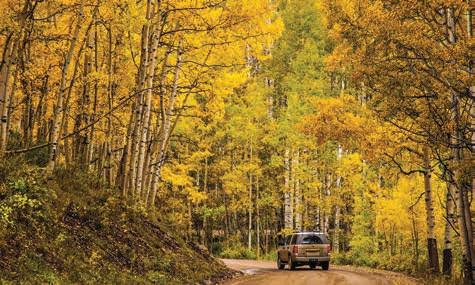
Dan Leeth
sits along Anthracite Creek, surrounded by a mix of evergreen conifers and deciduous color.
Six miles down the road from Erickson Springs, Kebler Pass Road T-bones into Colorado 133. The town of Paonia lies 15 miles to the west. It’s a short drive should an emergency need to replenish the bacon supply arise.
Lake Irwin Campground offers 25 sites, nine of which are tent only. Most can be reserved (877-833-6777, recreation.gov) in advance. The campground features three vault toilets and hand-pump water. There are no hookups and no dump station. Fees run $18 per night. While open during the 2022 season, the campground will be closed for the entire 2023 season for renovation.
Lost Lake Campground features 18 first-come, first-served sites with two vault toilets and pressurized water spigots. There are no hookups and no dump station. Fees run $20 per night.
Erickson Lake Campground offers 18 first-come, first-served sites and one vault toilet. Bring your own water. There are no hookups and no dump station. Fees are $14 per night.
13 True
14 False. (Brands aren’t mandatory, tattoos don’t work as brands, and they’re allowed to go anywhere)
15 False. (Logo can only go on federally legal products; hemp is OK, though)
Trivia Photographs
Palisade grows famous peaches.
T-shirts proudly display Rocky Ford High School’s fearsome Meloneer mascot.







PHOTOGRAPH
BY
VIC SCHENDEL
through an aspen forest on the west side of Dunckley Pass near Yampa. The autumn foliage on this third week of September imparts a golden glow to the scene.
Photographer Vic Schendel first came to this spot years ago while hunting elk with a bow. He gave up hunting without having gotten an elk here, but the beauty of the landscape stuck with him, inspiring him to return with his camera.
Schendel has photographed aspens all across Colorado, and he has a few favorite places he returns to again and again. He loves Last Dollar Road near Telluride and Buffalo Pass near Steamboat Springs, but he has a special fondness for Dunckley Pass that captures his imagination, as it is incredibly remote without being hard to get to.
To photograph the creek, Schendel used an exposure time of 1/5 of a second to capture some of the motion of the water; he chose not to use a longer exposure to avoid excessive blur.
IN EACH ISSUE, Top Take features a reader’s photograph of Colorado. Submit your best photos for the chance to be published in Colorado Life. Send images with detailed photo descriptions and your contact information to photos@coloradolifemag. com or visit coloradolifemag.com/contribute.
This image was created with a Canon EOS 7D Mark II camera with a Canon EF 16-35mm f/2.8L II lens at 19mm, exposed at ISO 100, f/18 for 1/5 seconds.



